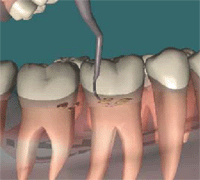Haptics-Based Virtual Reality Periodontal Training Simulator
September 1st, 2004
Categories: Applications, Devices, MS / PhD Thesis, Software, Virtual Medicine, Visualization, VR

Authors
Luciano, C.About
The haptics-based virtual reality periodontal training simulator project focuses upon the research and development of a prototype dental simulator for training of periodontal procedures. By the use of virtual reality and haptics technology, the periodontal simulator allows trainees to learn performing diagnosis and treatment of periodontal diseases by visualizing a three-dimensional virtual human mouth and feeling real tactile sensations while touching the surface of teeth, gingiva, bone and calculi with virtual dental instruments.
Since periodontics requires dentists to depend primarily on tactile sensations to perform diagnostic and surgical procedures, the use of haptics is unquestionably crucial for a realistic periodontal simulator.
The haptics-based virtual reality periodontal training simulator has been validated by experiments conducted by the College of Dentistry with faculty members and dental students, which demonstrates the scientific contribution and usefulness of the simulator as a vital part of the curriculum of the Department of Periodontics at UIC.
The use of medical simulators has proved to increase patient safety and reduce risk associated with human errors in hospitals by allowing medical students to develop skills more efficiently in a shorter period of time. Even though medical simulators are currently being developed by a large number of universities and medical companies, the field of dental simulation has not been well exploited yet. This thesis focuses on the research and development of a haptics-based dental simulator specially designed for training and performance evaluation of dental and hygiene students and practicing professionals in Periodontics. The simulator is the result of a multidisciplinary project developed by the Electronic Visualization Laboratory of the Department of Computer Science, the Industrial Virtual Reality Institute of the Department of Mechanical and Industrial Engineering, and the Department of Periodontics at the University of Illinois at Chicago. The goal of this collaboration between the College of Engineering and the College of Dentistry at UIC is the implementation of a dental simulator to help increase the quality of training for students and future practitioners in the field of periodontics.
The simulator allows trainees to develop the skills needed to differentiate pathological and normal conditions, as well as to diagnose and treat periodontal diseases. Trainees can learn by feeling tactile sensations as they “touch” a computer-generated 3 dimensional (3D) model of a human upper and lower dental arches along with various oral components: teeth, gingiva and bone with a haptic device. The simulator also facilitates the learning of proper selection and manipulation of dental instruments to perform
periodontal procedures.
This thesis is organized in six chapters. Chapter 2 presents an overview of the current commercially-available medical simulators, followed by manikin-based and haptics-based dental simulators previously developed. Chapter 3 gives background information about the diagnosis and treatment of most common periodontal diseases and proposes the use of haptics-based dental simulators to facilitate the learning of these activities. Chapter 4 shows the implementation details and the graphical user interface of the virtual reality periodontal simulator. Chapter 5 describes the use of the simulator for periodontal training, and reports the results obtained after its validation by the College of Dentistry at UIC. Finally, chapter 6 outlines the conclusions of this work and suggests future research and development.
Resources
Citation
Luciano, C., Haptics-Based Virtual Reality Periodontal Training Simulator, Thesis in partial fulfillment of the requirement for the degree of Master of Science in Computer Science, September 1st, 2004.